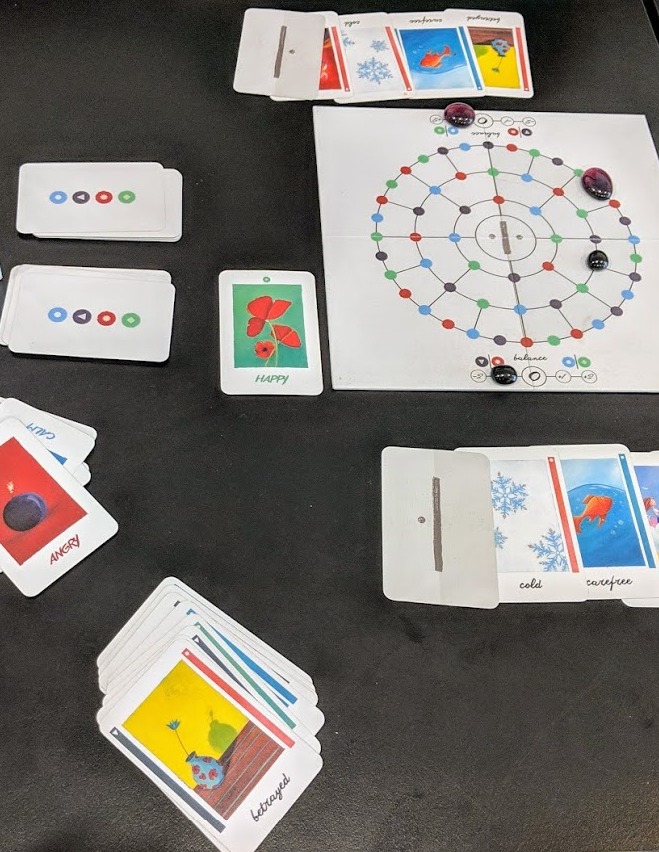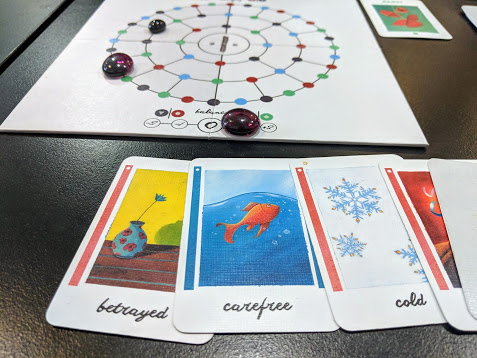“Nice weather we’re having.”
“I agree. That makes me calm. If you catch my meaning.”
“I really don’t.”
“You really should have. Now we lost the game.”
The very confusingly titled …and then, we held hands. is a game for exactly two players in which you and your partner navigate your upset emotional landscape and hopefully reach peace and balance by the end. There is a central board you move on, with a grid of interconnected coloured dots. There are four colours, representing four primary moods (happy, sad, calm, angry), and your objective is to visit a certain number of nodes in random order.
In order to move on the moodgrid, you play double-sided cards called emotion cards, each of which are built from two of the primary moods. (There is no better word for them in the game, what I call mood is called objective in the rulebook, which is silly.) For example, sad and calm combines to resigned. It’s usually quite clever. You can play the other person’s emotion cards as well, and there’s also a neat mechanism which makes you only see half of the emotion cards at a time, so you can only use it to move on one of the two primary moods present on your card.
You also need to keep an emotional balance, which is achieved by visiting the same amount of positive (happy and calm) and negative (sad and angry) mood nodes, in order to draw new double-sided emotion cards. Without these cards, you can’t move, and that’s how you lose the game. And while we are at it, you win the game by collectively beating 24 of the objectives, and then simultaneously moving to the inner circle of nirvana while maintaining perfect emotional balance.
Oh, and since it would be too easy otherwise, there’s no discussing the game during the game.
The Good

You know the game is quite bad when the first thing I praise about it is the artwork. So let’s start with the artwork. It’s good. It’s OK. The cards are nice, elegant, I like the small box, the smooth pastel colours. Well, it’s not like the artist had a difficult job, there are 4 + 8 = 12 cards in the game plus the box art and that’s about it.
And I just realized I don’t even fully like the artwork, see each player has two markers they use to track their emotional balance and the progress on the mood grid, and mine were much smaller than my partner’s. It might be my insecurity but for the love of god, I could not ignore the fact. It looked like the pieces were lost and the store owner just grabbed whatever they found in the junk drawer to replace them.
And now I had to google that to see if that’s indeed the case to make sure I do not come across as unprepared (doesn’t seem to be the case by the way, pieces are usually mismatched) and I found images with a version of the game that has very minimalistic artwork, so just to be clear, I’m talking about the version drawn by Marie Cardouat, the lady who did Dixit and stuff.
One other thing to highlight about the game is how refreshing the theme is. Paper-thin as it is, at least we are not in a fantasy world getting chased by zombies.
The Bad
This game has my all-time most hated mechanism: the “absolutely no game-related communication” rule. Similar to The Mind, or Magic Maze, it is there to cover the lack of clever and challenging mechanisms. Out of these three games, …and then we held hands. (boy, it is an annoying title, back to that later) seems to be the worst-case to me, because nothing in the rules would organically suggest that the game should be played in silence. With The Mind, at least it’s obvious that if you discuss your cards, the game becomes trivial, and with the Magic Maze, at least it’s somewhat funny. Here, with a game about repairing your failing relationship by understanding each other’s needs, there’s no thematic reason whatsoever, and it seems like playtests found the game to be very easy to beat, so the developer added the no-talking rule as an afterthought.
Let me quote a sentence from the rulebook here: “The players may discuss anything else while playing the game e.g. taking the opportunity to talk about something important or to just pass the time and enjoy each other’s company.” If you need idle chat to get through the dullness of the game, well, you might as well skip the game, right? I mean, that’s called having a conversation. It feels like you’re just a very boring and unnecessary third wheel in this situation.
I don’t like games that assume they have to be more than a game, and in doing so, fail utterly as a game in the first place. These underlying esoteric-sounding vague suggestions that involve the words explore, emotions, solution, synchronisation, they make me feel uncomfortable, like I’m in a hand of a delusional and ineffective torturer, and I feel sad for the game for its delusions of grandeur. And no, I am not repressed, there are plenty of games I can get completely lost in with the other person, these games just don’t tend to shout it out as a bold mission statement before I even started playing.
I praised the theme for its originality, and I stand by it, but I was really scraping the barrels for something positive to say. The theme is only very loosely connected to the gameplay, it feels like an abstract puzzle of moving on a grid, and needing colored cards to do that. What it does not feel like is a rollercoaster of emotions in a relationship problem.

The puzzle aspect is also not really intriguing. You can’t really plan ahead a lot, and your decisions are more or less determined by the time you start your turn. There’s always one colour to move towards, you locate the two or three that is closest to you, and then you discard cards, either yours or your partner’s. You try to remain in balance so you can re-draw cards, but if not, that’s not an issue, you’ll just get it next turn. Because you don’t know what the next objective is going to be, you can use anything, and then luck will decide where to go next. There are obvious strategies like using up cards from the player that has a lot of that colour, keeping a lot of cards in hand, moving towards the centre when you can. The complexity is just not there, I didn’t feel like I made any meaningful decisions.
And finally, the name of the game, very original, yes, good for you, I mean it starts with three dots, mid-sentence, not a capital letter in sight, and then ends with a dot. It’s a nightmare for an alphabetic system or to mention it in a review. I don’t like it.
The Co-Op
Well, there is some co-op in the game, of the reverse kind, so helping the other player usually brings you in a worse state, and vice versa. You can use the other player’s cards to move, which makes your life easier, but they will miss them on their turn, or you can move yourself in emotional balance to redraw your hand so your partner can potentially use them. So something is there, yes. And this is what saved the game from the dreaded triple-1 score.
The Recommendation
Nope.
I would recommend that you discuss your problems instead, with outspoken words, like a normal person. Maybe one of you is angry because the other made them play …and then we held hands. (sigh), but now it’s over so they are happy again.
Info
| Release Year | 2015 |
| Genre | Puzzle |
| Difficulty | Easy |
| Number of Players | 2 to 2 |
| Length | 15 minutes |
Rating
| Overall | Terrible |
| Story | Terrible |
| Co-Operation | Bad |